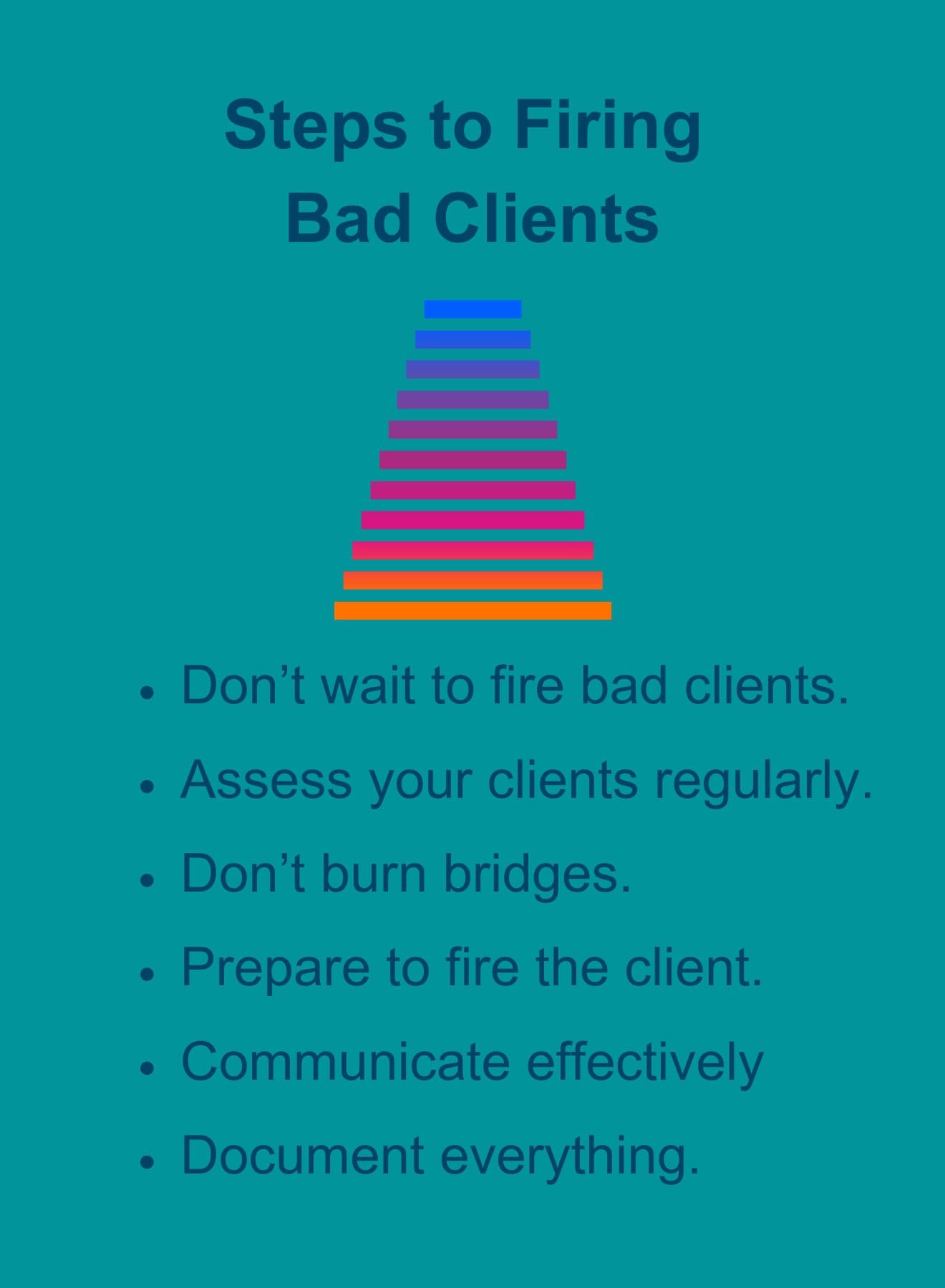Breaking Free: A Freelancer’s Guide to Firing Bad Clients
 Bad clients drain your time, energy, and enthusiasm—leaving you frustrated and underpaid. Great clients help you build a stable, successful freelance business. While firing bad clients can be scary, doing this gives you time and space to work with the great clients you deserve.
Bad clients drain your time, energy, and enthusiasm—leaving you frustrated and underpaid. Great clients help you build a stable, successful freelance business. While firing bad clients can be scary, doing this gives you time and space to work with the great clients you deserve.
When a healthcare communications agency contacted me about writing newsletters for patients about eight years into my freelance business, I was thrilled. This was a perfect match for my journalism background and my experience as a medical writer.
So we started working together. The work was fun and the deadlines were reasonable. The agency paid me well. And the people I worked with were super nice.
But after a few years, they hired a medical director (a physician) who focused too much on pleasing the client and too little on ethical and appropriate communication of medical content.
I wrote a story about cancer clinical trials that explained the role of research in cancer care and included the benefits and risks of participating in clinical trials.
The medical director deleted the risks.
All medical writers, and certainly all physicians, know that content about clinical trials must include both benefits and risks. I tried to discuss this with the medical director. I was polite and professional and sent her information from the National Cancer Institute about the need to cover both benefits and risks.
She didn’t care and refused to revise the story. This was very unethical.
So for the first time as a freelancer, I fired a client. Doing this was awkward and uncomfortable.
But I felt so much better afterwards. And I easily replaced that client with a better client.
Firing Bad Clients Boosts Your Income and Your Energy
Bad clients like this drain your time, energy, and enthusiasm—leaving you frustrated and underpaid. Great clients—clients who pay you what you’re worth, give you steady freelance work, and treat you right— help you build a stable, successful freelance business.
Yet, most freelancers hesitate to fire bad clients out of fear of losing the work and the income, and worry about not being able to get new clients.

Firing a client is hard, especially the first few times you do this. It’s even harder to let go of decent clients who no longer meet your needs. For example:
- As a new freelancer, you’ll probably work with lower-paying clients. Once you build your business, it’s time to move on to bigger, better clients.
- If you’re doing a different type of work to get experience but the very tight deadlines are too stressful for you, get the experience and then move on.
Signs of bad clients
Bad clients stand out for all the wrong reasons. Signs of bad clients include:
- Scope creep
- Unrealistic expectations
- Poor communication
- Micromanagement
- Low or late payments
- Lack of respect.
Learn more about bad clients
Less Stress, More Success: How to Find Great Clients
6 Steps to Firing Bad Clients (or Letting Clients Go)
Whether you’re firing a client or letting a client go, always be professional.

#1. Don’t wait to fire bad clients.
Always trust your instincts. If you start to dread doing work for a client or interacting with them, it’s time to fire them. Bad clients rarely get better. But make sure you honor your contracts and do what you had agreed to do first.
#2. Assess your clients regularly.
Once or twice a year, assess all of your clients. Look for clients who you may not have identified as bad clients. This can happen when there are multiple small issues with a client that together make the client a bad client.
Also look for decent clients who were good clients for you when you started working with them but are no longer important to your business.
#3. Don’t burn bridges.
Leave the relationship with your reputation intact and an open door to future freelance opportunities.
People get new jobs. If you fired the client because the organization’s culture led to big problems or you let the client go for business reasons, and your contact moves to a better organization, new freelance opportunities are possible. And if a specific staff member caused the problems and that person leaves, there may be new opportunities for you at the same organization.
#4. Prepare to fire the client.
Put your thoughts down in writing. Understand why you are firing the client.
Review your contracts, agreements, and for current projects, emails. Make sure you meet all of your obligations. Contracts outline how both parties can end the relationships (e.g., upon 30 days written notice).
Choose the right time. Finish any projects you’ve committed to work on. Try not to fire the client during their peak project periods.
Write a script, outline, or draft email of what you want to say. Think about how the client might react and how you will respond, including if they suggest fixing the issues. Usually though, once you’ve gotten to the point of wanting to fire the client, it’s unlikely that the issues can be fixed.
Letting a decent client go
If you’re letting a decent client go, be positive and affirming. Make it clear that you have enjoyed working with them and your decision has nothing to do with them.
#5. Communicate effectively.
Being prepared will help you be clear and confidence whether you’re firing the client by email, video meeting, or telephone. Personally, I prefer email when I’m firing a client. If I’m letting a client go, I would probably do it over Zoom or in a telephone call.
Make sure you comply with your contract (e.g., providing 30 days written notice).
If you fire the client in a video meeting or telephone call, document the end of the relationship in an email afterwards.
To communicate effectively when firing a client, be direct but polite. Keep the conversation short, clear, and free of unnecessary tension. Being polite will help you maintain your reputation.
Focus on business, not emotions. Avoid personal remarks. Frame the decision as a business necessity.
#6. Document everything.
Keep a record of all communications regarding the termination. This protects you if misunderstandings arise later.
What to Do After Firing a Bad Client or Letting a Client Go
After firing a bad client or letting a client go, take a few minutes (or more) to celebrate.
Know that you can get great clients who pay you what you’re worth, value your work, and treat you right. To do this, you need to focus on two things:
- What clients need and how you can meet their needs
- What works best in marketing a freelance business (networking, LinkedIn, and direct email).
Learn more about client needs and how to get the clients you deserve
Less Stress, More Success: How to Find Great Clients

Learn More About Firing Bad Clients
Free Guide:
10 Steps to Your Freelance Success: The Ultimate Guide
Blog posts:
Less Stress, More Success: How to Find Great Clients
How to Use a Red Velvet Rope to Get Your Ideal Clients
3 Easy Ways to Get the Freelance Clients You Deserve in 2025